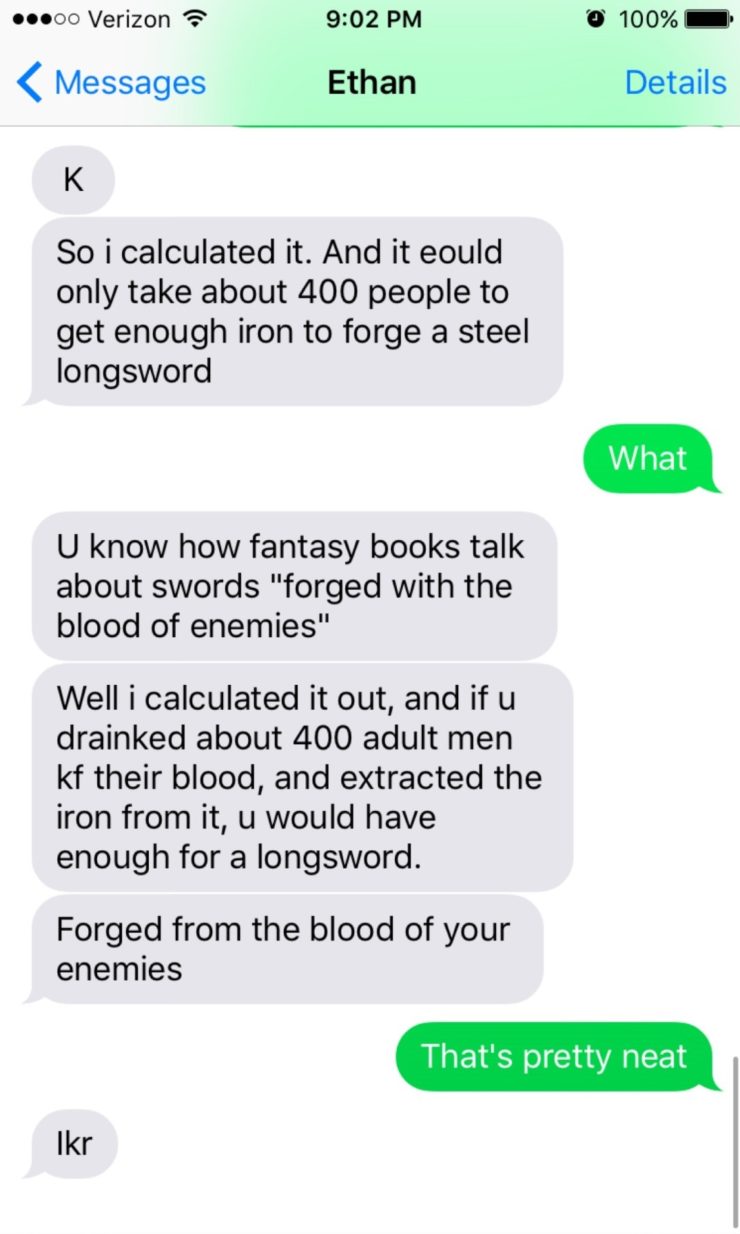Tumblr did the math. And then it got weird.
Whenever big tough fantasy types want you to know how big and tough they are, you may come across the phrase “forged from the blood of mine enemies” where weaponry is concerned. But is that really a practical exercise for sword-making? Inquiring minds want to know.
Turns out, you can math that.
Tumblr blog macaedh graced the internet with a text exchange from “Ethan,” who apparently worked this whole problem out. And with the addition of a few more math-minded pals, the exact amount of dead enemies have been worked out for more than one type of sword. Check it:


So. High fantasy math has made it clear that you need to kill at least 225 un-friends before you get such a fancifully morbid weapon. But 400 is probably the average for a big ol’ blade.
Anyway. Life goals.
Top picture by Welcome Images. CC-BY-4.0, CC BY 4.0.











I’m glad someone said to use the blood to simply temper the blade. The carbon from the burnt bodies was not something I had thought about before, but again – the purity of it is in question.
I wonder what the ratio of success would be? Oil is the most common. Water has a high fail rate.
Question: How is the iron extracted from the blood? How complicated a chemical process is that, and would the necessary knowledge and technology have existed in a pre-firearms age?
Also: Is this really something that fantasy characters commonly say? Can someone offer some specific references to fantasy works that use this phrase? I mean, I’m pretty sure I’ve heard of things like carving tankards from the skulls of one’s enemies, and of course there’s Jack’s giant grinding bones to make his bread (how does that even work?), but forging swords from blood seems like more of a reach. I think I’ve heard of swords being anointed with the blood of enemies, or seasoned like you do with a cast-iron skillet, but that’s just a metaphor for, y’know, killing a lot of enemies with it. The boast of actually having made a sword from blood sounds a bit further afield to me, and I have to wonder if it’s a case of something being remembered inaccurately.
@2 Question: How is the iron extracted from the blood? How complicated a chemical process is that, and would the necessary knowledge and technology have existed in a pre-firearms age?
That was the question I was going to ask. Of course in a Fantasy setting, Blood Magic could infuse a persons “essence” into a blade but that tosses out the entire math part.
Besides we all know “forged from the blood of mine enemies” is a rhetorical statement not a literal one.
This is the best thing on the Internet today. Possibly all week……..
—Keith R.A. DeCandido
The old threat was to slake one’s sword in the blood of one’s enemies (ie. satisfy its presumed thirst for the enemies’ blood). I think that a misunderstanding of this led to the idea of “making” a sword from blood.
I’ve just tried googling “extract iron from blood” and:
1) Many other people want to know, and most of them want to make swords from the blood of their enemies.
2) There’s a whole paper on it.
3) I don’t even want to know what this is doing to my search history.
@5/roses: Ah, that’s what I suspected.
@6/phuzz: Is there a tl/dr summary for that paper?
Extracting the iron would be a little problematic, yes. Probably a 2-stage process, first a centrifuge to partially isolate the hemoglobin, then boiling off the hemoglobin to leave trace iron residue. Even working with large quantities of blood, you’d be left with flakes at a time, but if you were patient enough it seems doable at even basic levels of tech.
Re. tempering, one wonders just what quality of quench blood would give you, relative to oil, water sans salt, water with salt, etc. I’m sure that somebody with the appropriate specialist knowledge is out there with something like a reasonable answer.
In short way more trouble than it’s worth.
@6
I sometimes just write in random searches in google. You’d be amazed what you learn. And frankly a little concerned about the rest of the human race. (word of caution: be really careful , rule 34 is a thing)
On topic, I’ve always assumed that the blood thing was a metaphor. On the other hand, drinking from your enemies skull is doable given that and inverted skull won’t leak. (Don’t ask how I know that)
Uh, the term refers to shoving a hot newly forged blade into a human. It was supposed to make a superior weapon.
@2 For blood as a tempering agent, Saberhagen’s “The First Book of Swords” comes to mind.
The phrase is supposed to be *with*, not *from*, the blood of ones enemies.
Supposedly, Damascus steel blades’ final tempering was to heat them to a low orange, allow them to air cool to a barely-glowing deep purple, then impale them into the belly of a captured enemy or a muscular slave. That’s described in many contemporary documents from Asia Minor.
Referring to the comments about tempering a sword in blood, there is actually a bit of sense in that but deeply hidden.
There exist a method to increase the hardness of the surface of a steel part by infuse it with Nitrogen atoms, technically this is called nitriding and is nowadays done by placing the steel part in a oven filled with ammonia at a controlled temperature and time.
There is indications though that ancient smiths know how to do something similar by heating a steel part (like a sword) to dark cherry red and quenching it in a nitrogen containing liquid. Blood due to its proteins, which contains Nitrogen would work but most weapon smiths actually preferred urine witch also contains a lot of Nitrogen.
Since no one understood the part Nitrogen played it was instead assumed the the source of urine was important and we have literal sources that insist that either urine from priests or from virgins was superior to all other forms of urine.
There is also a myth that smiths actually pierced body’s with a glowing hot sword to temper them but glowing hot steel is soft like putty and trying to do so would only bend the sword.
The vikings made swords by collecting grass that grew over iron rich land and burning it down to get the iron out. So if they could make swords from the grasses of their Sheep I am sure they could have made some with the blood of their enemies. For more info here is a good link http://www.hurstwic.org/history/articles/manufacturing/text/bog_iron.htm
@15: in natural dyes ammonia is good for setting colors. Myth had it that the urine from red headed boys was the best urine to use. There was a study, that I can’t find now, which indicated that red-heads and diabetics do, in fact, have the most ammonia in their urines. So would be good for dye setting.
@2 The first I heard of making a sword from the blood of your enemies was in Making Money by Terry Pratchett. Supposedly it was one of the rumors about Lord Vetinari, his of course was a cane sword. The villain of the story was trying to become Lord Vetinari by wearing his clothes and acting like him (he may have been a little bit off his rocker), so he was paying a guy to filch his belongings. This person’s big score before jumping town was to convince him that he could get Vetinari’s Cane Sword. The fake he sold him sure looked the part though. Of course no such thing really existed in the first place.
The irresponsible use of math always makes me happy.
@12/MByerly, 14/Josh, 15/Dreamwolf: Thanks, all of you, that’s very informative!
I guess the stories of swords being tempered that way were propaganda to intimidate enemies. I.e. “We’re so badass we kill people just making the things we kill people with!”
Lord Vetinari is far to awesome to own such a silly item. He can make words into deadly weapons and intimidate with a casual glance. Who needs a sword cane?
@2 Question: How is the iron extracted from the blood?
Well, you could just ask Magneto to give you a hand.
I also always imagined such sentences refer to tempering the sword with blood. Actually doing it from blood sounds a bit creepy.
@22/Celebrinnen: And tempering it with blood isn’t creepy??
ChristopherLBennet @23, touché. It is. The whole weapon-enemy-blood business is. But this way it just seemed a bit … more creepier?
One could temper it in a barrel of pig’s blood…
In Jack Vance’s THE BLUE WORLD, iirc, set on a oceanic world where humans have almost no access to metals, the protagonist slowly accumulates quantities of his own blood and extracts the iron. Not for a full sword, but enough for a harpoon point to counter-attack a kraken.
What about the deadly swords of the Fades in the Wheel of Time? Pretty sure they were “finished” by plunging them into the body of a human. One human per sword, that’s not as wasteful as 225, but still…
Also, I now know more than I ever wanted to know about this topic :D
~lakesidey
The vikings made swords by collecting grass that grew over iron rich land and burning it down to get the iron out.
Bog iron forms when soil bacteria reduce iron as part of their metabolism into nodules that you harvest directly, it doesn’t bioconcentrate in grass. It’s still a fascinating story though!
One could temper it in a barrel of pig’s blood…
FORGED FROM THE BLACK PUDDING OF MY ENEMIES
Once you’ve killed 400 enemies, how many do you reasonably have left? No sensible ones I can tell you!
As a blacksmith who has made iron the traditional way, I have some thoughts. A matter that is forgotten in the calculation is that both making the iron billet itself and the later forging of the blade consumes metal. One would need considerably more unwilling blood donors than the 400. As to the method of extracting the iron, it might be feasible to dry it, then burn off most of the organic compounds before putting it into the ironmaking kiln.
@29
That is the sort of thinking that has got us all into such trouble in the Middle East. Most of those 400 have families, all have friends; by killing 400 for such a frivolous reason which desecrates their bodies, you now have considerably more than 400 enemies. The easiest way to create ten enemies is to kill one enemy. For the purposes of this discussion let’s hope that sword was worth it, because the tyrant who created it is going to have to use it a lot.
Actually 400 would be accurate only if you made a sword out of whole humans and you’d have to rip most of it out from the proteins in your body. Actually if you counted only iron circulating through plasma , you would need blood of 147826-614302 people, since a concentration of that iron is about 0.5-1.7 mg/l of blood (and that is assuming no one has anemia or is malnourished). Even in a fantasy world I don’t think that number would be manageable. But then again, in a fantasy world ripping iron from every cell of one’s body by magic is as valid idea as taking only the one in plasma (although then a sword from blood of enemies wouldn’t be an accurate description).
@31 If you killed entire family and social groups, you could probably do a fair amount to minimize the propagation of any vendettas. Granted that would mean killing a fair amount of kids which would drive up the total number of required corpses. Some things can’t be helped.
@33 The worst thing a fictional character can do is try and wipe out an entire family/clan/ethnic group. They always miss one kid, and that kid always turns out to be the chosen one of prophecy.
@35 They just need to try harder and recognize that mercy only makes things worse.
Going off the carbon from burning bodies, could your enemies bodies burn hot enough to act as the fuel for the froge which is forging the sword made from their blood?
@31. Thanks, you’re 100% right :)
Is it just me or did this thread turn EVEN darker after my comment?
@33,34, that’s why ‘an eye for an eye’ was actually an ethical advance. Tit for tat and that ENDS it. No vendettas.
Well, I know what I’m doing with my afternoon. On an unrelated topic, anyone wanna hang out with me at my house?
@6,
If you’ve not had large men show up in a black SUVs yet, you’re probably OK.
Of course, it could be “forged from [the money I made spilling the] blood of my enemies.” Chances are most warriors wouldn’t be able to smelt, forge, or temper a blade; they’d have to hire a tradesman.
Ok. How about this? Forging a sword from your own blood. Think about going into battle with a sword forged by your own blood! You would definitely have a personal relationship with that sword!
In order to do this, here are the calculations:
According to NIH https://clinicalcenter.nih.gov/blooddonor/donationtypes/hemochromatosis.html a pint of blood contains 250 mg of iron. The average grown man has over 1.25 gallons, or 9 pints of blood, or 2.25 grams of iron in their blood. If you make a sword that is 1000 grams, a fairly light but a reasonable long sword, here is what you would have to do:
You would have to drain a pint of blood each week for 76 years. You would have to start as an adult, so, you would be well in your 90s when you were finished. It would be easy to extract the iron from the blood, since we are able to smelt iron out of ore, we could just smelt the iron out of the blood that has been collected into a large vat.
So, once you have forged your sword, you would be quite an anemic old man ready for battle!!! But isn’t that a great thought?
My apologies, as the result of growing frustration reading the comments I have just stoped to the end to write my own.
Thus if someone has already covered this I am sorry.
1, The saying forged in the blood of my enemies is a poetic way of saying, I have honed my skills with this blade by killing lots of people. Or similarly as you can be forged in battle, (becoming a new better person, (in the eyes of those who live battle)) the same can be said for the sword, it has improved and changed due to use in battle. A form of growth.
2, The math does not even begin to take in to account wastage, I have forged multiple swords, and a 1.6 kg sword was my favourite and I had a lot of waste to get the balde balanced and sharp, at the very least it you are skilled you need 2kg.
3, you do not want to temper your blade in any kind of blood, for kicks I tried pigs blood. It just made a mess of the blade and a bad smell, it’s also worth noting that you don’t temper unless you are nearly finished or you have to stop and can not put the blade anywhere else.
Ant way rant over, feel free ti argue with me on any of the above points, if only because I started making blades because in my fantasy I wanted a blade forged in the blood of my enemies, and I have no issues with people helping me to keep that dream alive.
@43,
We’re a very literal group, here ;)
When swords were actually useful military weapons, looting the dead, prisoners, and enemy civilians was de rigueur, so the warrior’s boast could be about the sword(s) bought by the money earned by killing people.
A wooden sword is also known as a training sword and is known for training purposes. They are made up of durable wood and are used by people to train themselves on the art of swordplay safely.